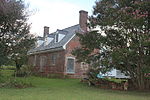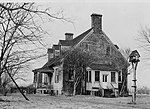Bacon's Castle

Bacon's Castle, also variously known as "Allen's Brick House" or the "Arthur Allen House" is located in Surry County, Virginia, United States, and is the oldest documented brick dwelling in what is now the United States. Built in 1665, it is noted as an extremely rare example of Jacobean architecture in the New World. The house became known as "Bacon's Castle" because it was occupied as a fort or "castle" by the followers of Nathaniel Bacon during Bacon's Rebellion in 1676. However, contrary to popular folklore, Bacon never lived at Bacon's Castle, nor is he even known to have visited it. Today Bacon's Castle is an historic house museum and historic site open for guest visitation. Bacon's Castle is an official Preservation Virginia historic site and operates under its 501 (c)(3) not-for-profit status.
Excerpt from the Wikipedia article Bacon's Castle (License: CC BY-SA 3.0, Authors, Images).Bacon's Castle
Bacons Castle Trail,
Geographical coordinates (GPS) Address External links Nearby Places Show on map
Geographical coordinates (GPS)
| Latitude | Longitude |
|---|---|
| N 37.109027 ° | E -76.722384 ° |
Address
Bacon's Castle
Bacons Castle Trail 465
23883
Virginia, United States
Open on Google Maps









